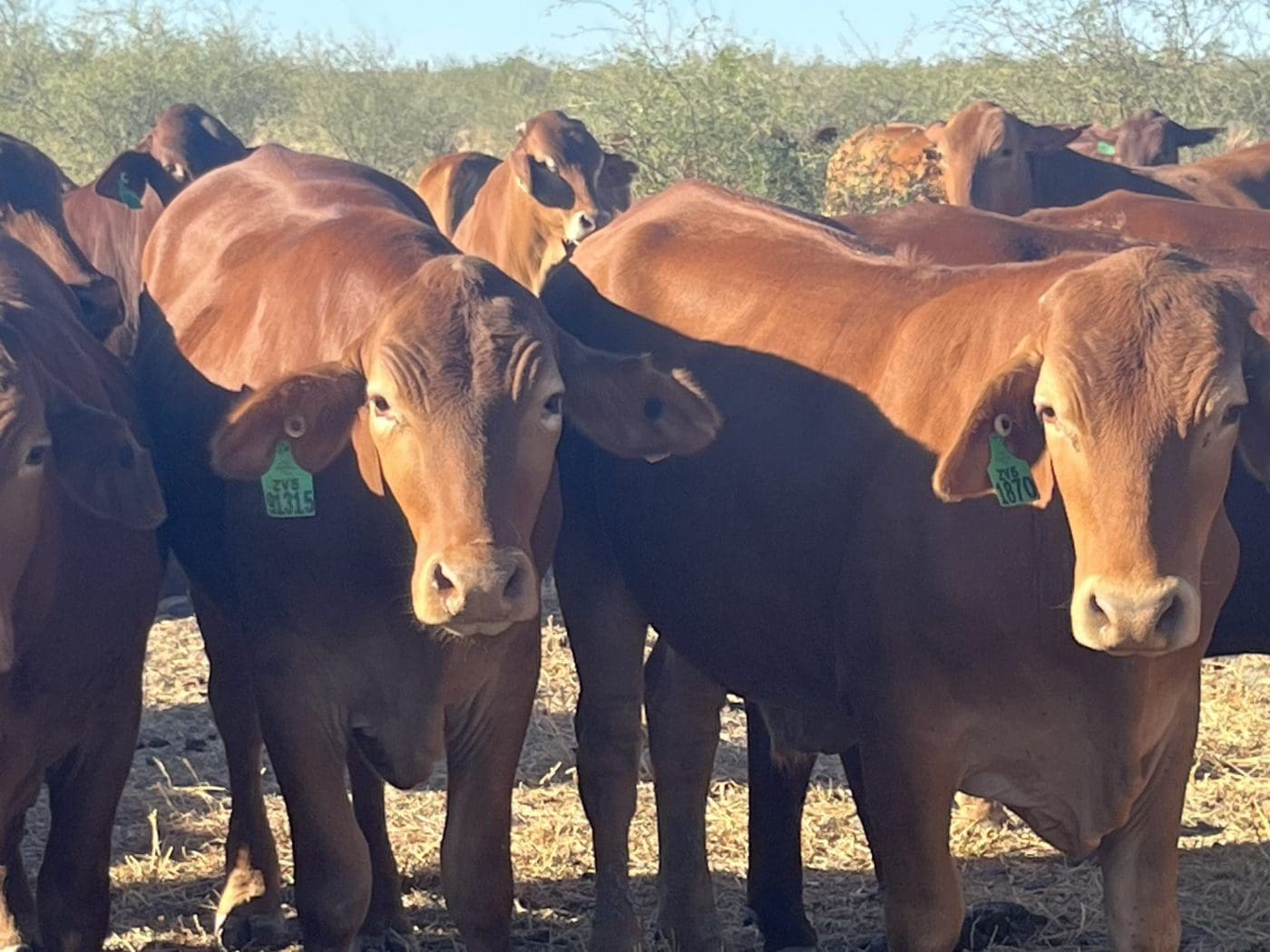
Some of the 4000 Droughtmaster steers involved in the June transaction
This item continues our series on smart cattle trades in 2024 – see yesterday’s opening article on Nigel Kerin’s heifer project
CHANGING seasonal and market circumstances on either side of the continent set up a novel large-scale trade in Fitzroy Crossing-bred backgrounder cattle earlier this year.
More than 4000 well-bred Droughtmaster backgrounder steers bred on Fitzroy Crossing region holdings were part of a deal put together by Dalby agent Peter Daniel from Grant, Daniel & Long (acting for Queensland buyers, Gibson Grazing) and Andrew Stewart from Kimberley Livestock & Property, working with Nutrien (acting for vendors, Hancock Ag and the Emanual family).
First, the back-story.
At the time the deal was done, there had been a lot of uncertainty surrounding the northern live export boat trade to Indonesia for 2024, with unusual delays in the issuance of annual import permits for Australian cattle and beef (see earlier story). Some northern live export operators had gone out on a limb, buying boat cattle in anticipation of the arrival of permits, only to get stuck with cattle for weeks, and in some cases months.
The delays, and the backlog after permits finally arrived, meant marketing options on the Fitzroy Crossing cattle started to narrow, and there was a risk that the longer it went, as they gained weight, they could become ineligible for the Indo live trade.
On the other side of the continent, unusually-late April/early May rain had fallen on Mick Gibson and family’s extensive Channel Country backgrounding and finishing property, Bulloo Downs.
The rain had fallen not in the channels themselves, but on outlying sandhill country, producing a proliferation of unexpected early-winter herbage and feed, and an opportunity to use it.
Rain like this is regarded as a ‘once in ten years’ type opportunity in this southern part of the Channel country, and Gibson Grazing had to act fast to exploit the window.
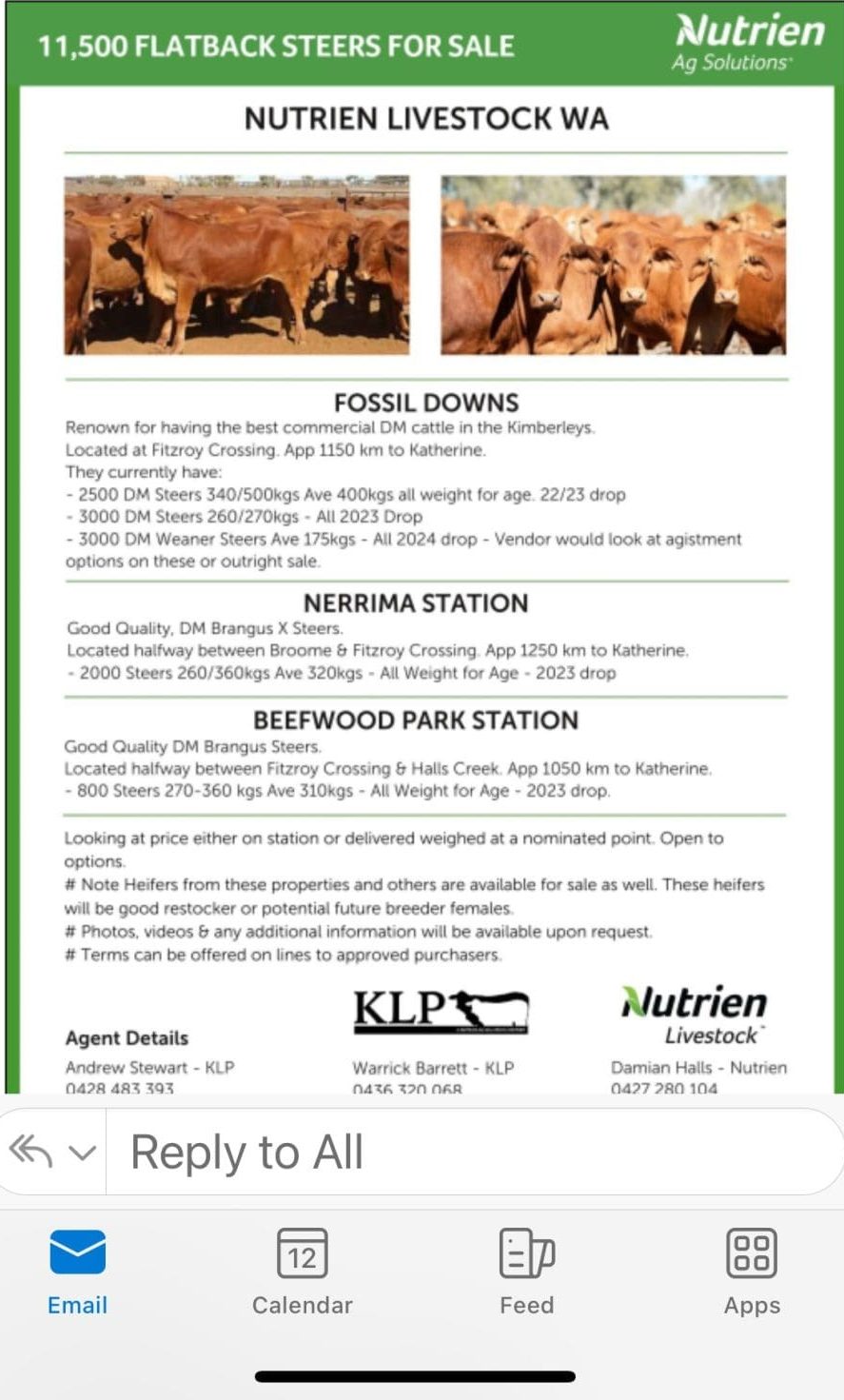 At much the same time, Kimberley Livestock and Property was listing large numbers of young steers and heifers off local Fitzroy Crossing holdings, held up by delays in live export. The listing appeared at the time in Beef Central’s popular Cattle Listings and orders section.
At much the same time, Kimberley Livestock and Property was listing large numbers of young steers and heifers off local Fitzroy Crossing holdings, held up by delays in live export. The listing appeared at the time in Beef Central’s popular Cattle Listings and orders section.
Gibson Grazing’s Liam and Dechlan Gibson and Peter Daniel flew across to Fitzroy Crossing, and did the deal – worth close to $5 million – on Fossil Downs.
The transaction that was struck was for 4000 well-bred Droughtmaster steers, softer types suitable for either feedlot or grass programs, mostly number 3s and a few 4s, aged 12-15 months averaging 320kg. The cattle were in fresh store condition, which surprised the buyers during inspection, because country further to the south of Fitzroy Crossing was very dry at the time.
The biggest portion of the consignment came from Hancock Agriculture’s Fossil Downs station, with the balance from Hancock’s nearby Liveringa station, and the Emmanual family’s Nerrima Station.
Hancock Agriculture’s Fossil Downs Droughtmaster herd is regarded as something of a benchmark for herd quality in the region, and the cattle had performed well in previous sales heading into Queensland.
“They were beautiful cattle by northern standards, a credit to the breeders,” Peter Daniel told Beef Central this week.
“Part of the attraction was being able to secure such large, even lines. It would have taken a long time to string together smaller runs of Queensland backgrounder cattle to accumulate the same numbers. And attempting to do that would have inevitably pushed the market for those type of cattle sharply higher, by trying to buy out of Roma or Dalby store sales, for example,” he said.
The lengthy delays in import permits for Indonesia had seen a backlog of cattle occur at the time, and with plenty to choose from, live exporters were preferencing high grade Brahmans at the time.
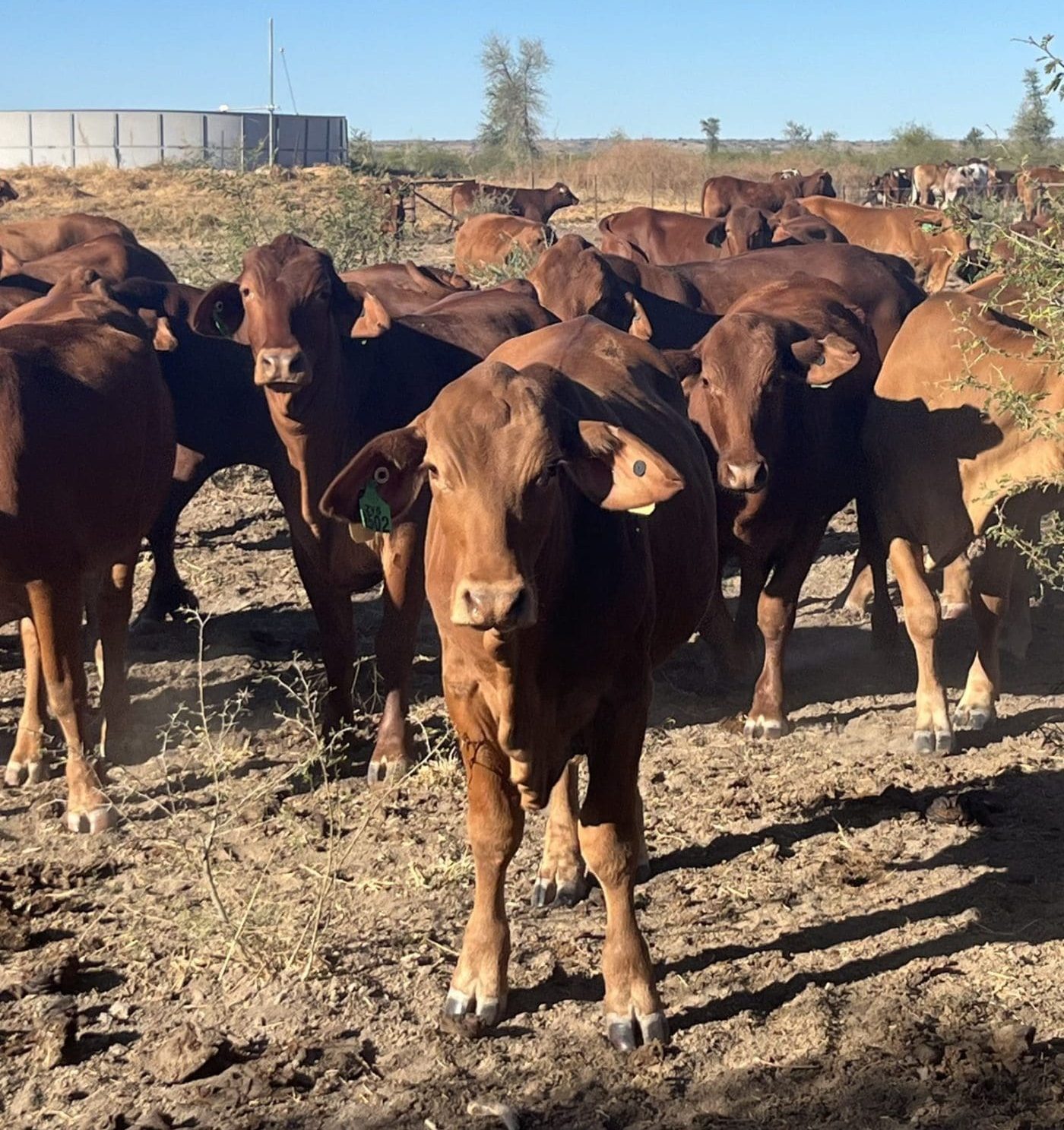 This put the value of the cattle back within range of Queensland buyers, and encouraged Hancock to look elsewhere.
This put the value of the cattle back within range of Queensland buyers, and encouraged Hancock to look elsewhere.
“At the time the deal was done, young cattle like this weren’t making a lot of money in Queensland, either, but the key motivator was that we were looking for 4000-5000 steers,” Mr Daniel said.
“But if we’d stepped into the market in Roma or Dalby chasing those numbers, all of a sudden the (local) steers would have been 20-30c/kg dearer.”
The deal was done in early June, with first delivery of 1100 head on 28 June, followed by two others of 2000 and 900 head through to early August. The biggest uplift involved 66 decks, or 11 triple-deck roadtrains.
“Logistically, it was a big job for them to do, out of season,” Mr Daniel said.
Sale and delivery terms
Sale and delivery terms were somewhat unusual.
The steers were bought for 340c/kg liveweight, but that price was weighed, dipped and spelled at Katherine for four days (1100km east of Fitzroy Crossing) and delivered to Cloncurry yards in Northwest Queensland (another 1400km). Shrink was also a considerable factor in the price.
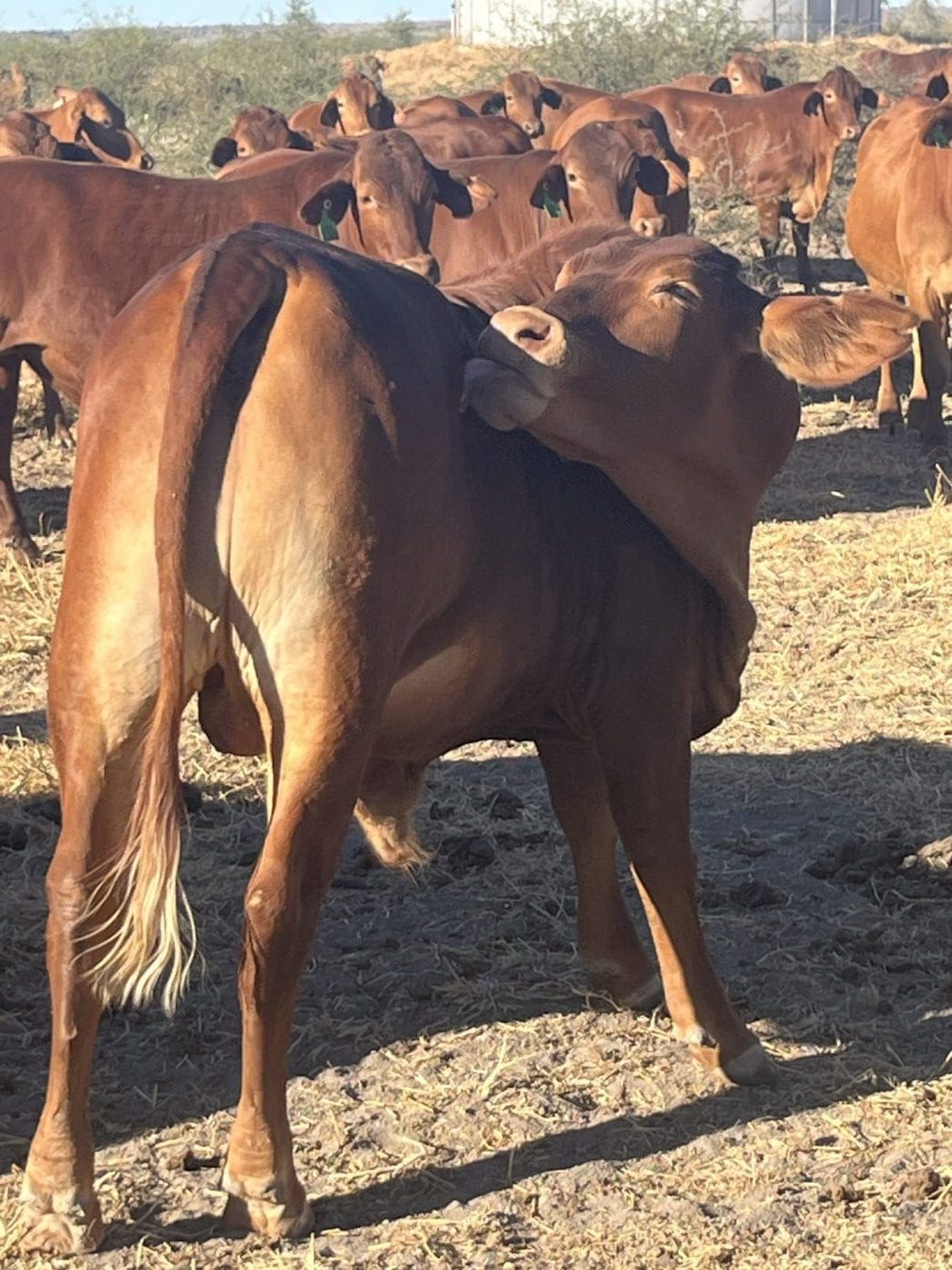
The buyers then picked up the remaining freight cost from Cloncurry to Bulloo Downs, a final leg of 1350km. That final transport leg plus spelling cost the buyer around 30c/kg, giving a landed price in the paddock at Bulloo Downs of about 370c/kg.
Logistically, it was a better and more efficient option to do a two-stage delivery process like this, rather than sending Queensland trucks (Frasers Transport, Warwick did the final uplift from Cloncurry) all the way to Fitzroy Crossing to load, during a busy time of year.
Turnoff begins
The 4000 steers that arrived at Bulloo between late June and August have reaped the benefit of a strong growing season, with the first wave about to be turned off at feedlot entry weights of 450-500kg at 0-2 teeth.
Another wing will be retained for entry into Gibson Grazing’s own Linda Park feedlot near Dalby for 100-day grainfed contracts, and if it continues to rain as it currently is in western Queensland, the remainder will be sold direct to processors as grassfed ox some time in the first half of next year.
Another 60mm of rain that fell on Bulloo this month has delayed any immediate movements for few weeks.
While the well-grown steers were in good, strong store condition at sale time, they still contained good compensatory gain in the paddocks at Bulloo, given the transport distance involved. Many have gained a kilo a day, or better, since arrival.
Win-win
As it turned out, this transaction proved to be something of a ‘win-win’ for both parties.
The vendors in the Fitzroy Crossing region were faced with limited marketing options, given the state of the live export industry at the time, meaning sending the cattle to WA’s far southeast for processing was one of the few remaining options.
For the buyers, the risk was that the cattle market might not go with them. At the time the deal was struck, similar steers at Roma were making around 370c/kg in the yards, and in fact drifted briefly to around 350c, before picking up sharply again.
But as said earlier, the real advantage to the buyers was in being able to access big, even lines of quality cattle, and there was every prospect that trying to buy them out of the Roma/Dalby markets would have pushed the local market sharply higher.
“This kind of project is not necessarily something that’s going to work every year,” Peter Daniel said.
“But the fortunate rain that fell last April-May on Bulloo, and the circumstances that developed in the Kimberley, set this up as an excellent result, for both the buyer and the vendor,” he said.
“But part of the idea was also to establish a relationship with those quality cattle producers in the Kimberley/Fitzroy region. We’d love to buy them every year, if we could – provided the circumstances allow.”
- This item continues our series on smart cattle trades in 2024 – see yesterday’s opening article on Nigel Kerin’s heifer project. This series continues next week.
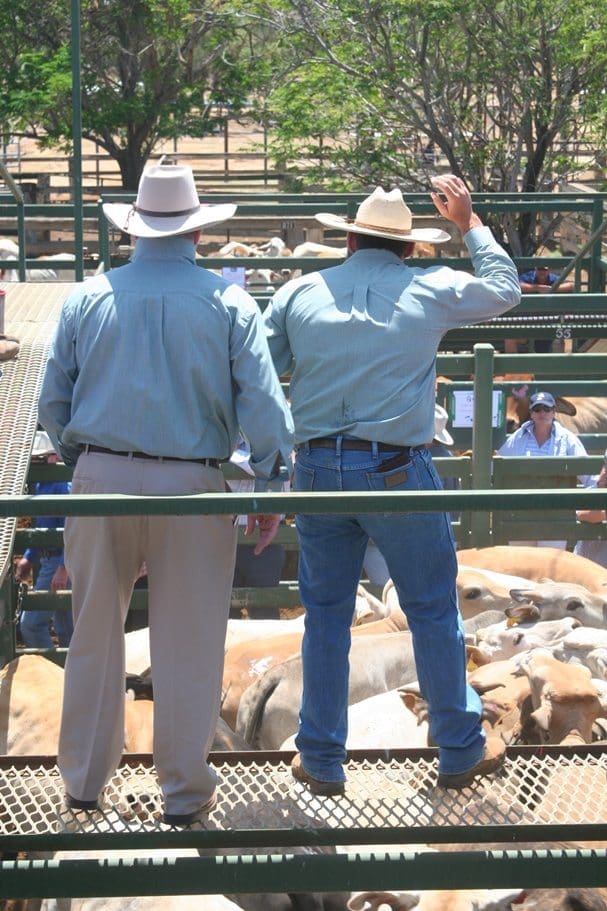 GOT a special offering of cattle to sell in the yards, online or out of the paddock? Expand their potential buyer audience to a massive national beef industry readership via a listing on Beef Central’s new Cattle Listings and Orders Noticeboard.
GOT a special offering of cattle to sell in the yards, online or out of the paddock? Expand their potential buyer audience to a massive national beef industry readership via a listing on Beef Central’s new Cattle Listings and Orders Noticeboard.
